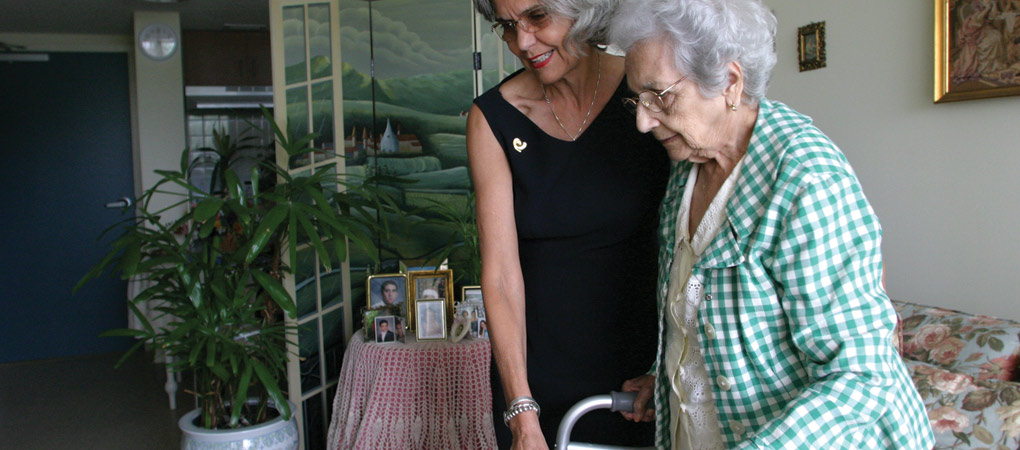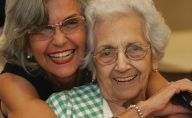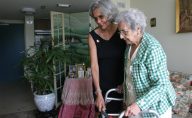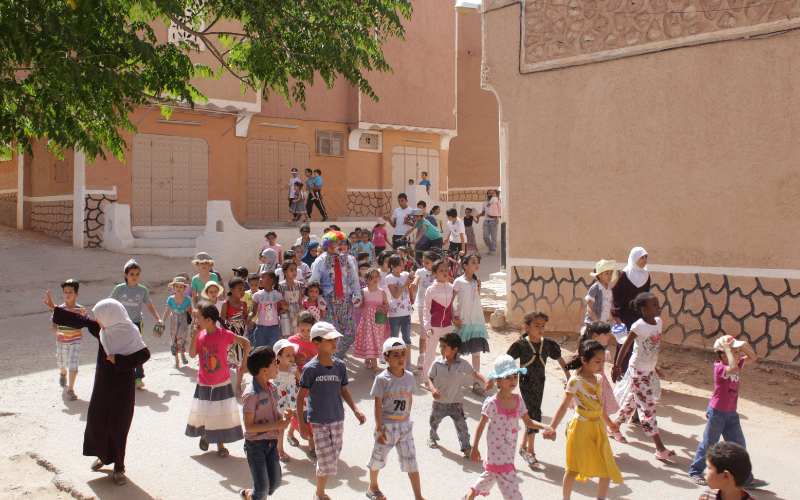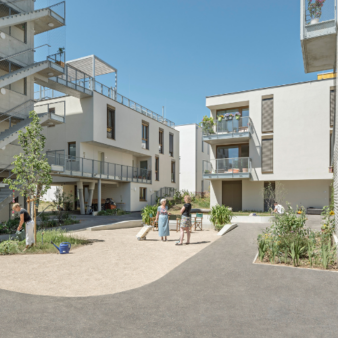Mia Senior Living Solutions (Mia) has developed an affordable assisted living model that allows low-income and disabled older persons living in public housing facilities to remain in their own homes with support, instead of being forced into nursing homes against their will when they reach the stage in life when they can no longer live independently. Over 5,000 people have been served to date through the programme, with an additional 12,000 clients moved from institutions back to the community and an estimated 50,000 more to be served in the next five years. Mia’s work has been implemented in 21 states within the USA and will be expanding to two additional states and the District of Columbia in 2012.
Project Description
Aims and Objectives
To provide housing and care options that enable older persons to age with dignity and live in society as respected and contributing members.
Context
Global population aging poses challenges to social institutions worldwide and in particular to health care systems. The current system in the U.S. drives older persons to needless premature institutionalisation and expensive and preventable medical interventions, burdening both the older persons themselves and taxpayers. Very little planning has been done to deal with the growing population of persons aged over 65. By 2030, the number of persons aged 65 and over will double in the U.S. to 20 per cent of the population, and the demand for assisted living places will increase to more than 1,900,000. Today 40 per cent of people aged over 75 years have annual incomes below US$10,000 and two thirds have incomes below US$15,000, making current private provision unaffordable.
Many low income older persons and disabled adults live in public housing. Public housing regulations require that their residents live independently and when not able to do so, they are evicted, ending up in costly nursing homes or without a home. In extreme cases they end up on the streets. Although private assisted living facilities (ALFs) have long existed for older persons who are able to pay hefty monthly fees (typically between US$3,000 and US$6,000 per month), low-income older persons and disabled adults are largely unattended by the market.
Key Features
Established in 1995 by Ms Conchy Bretos, Mia Senior Living Solutions (Mia) provides property and services management, consultancy and advisory services for the assisted living facilities industry. The Solutions to Global Aging project comprises an affordable assisted living model that allows low-income and disabled older persons living in public housing facilities to remain in their own homes with support, instead of being forced into nursing homes against their will when they reach the stage in life when they can no longer live independently.
Mia works directly with interested public housing authorities (PHAs) and affordable housing providers to conduct feasibility studies, retrofit buildings to meet ALF standards, leverage state Medicaid waiver funding to finance the ALFs’ start-up operations, recruit residents and staff, manage day-to-day operations and conduct performance and impact evaluations.
The model has been replicated in 40 projects that serve approximately 5,000 persons aged over 65. These affordable ALFs also generate employment in the daily care of the residents and the maintenance of the facilities, often leading to a gradual revitalisation of the frequently derelict or decaying urban neighborhoods where they are located. The model also includes a focus on changing lifestyles to enable older persons to become more active and healthy, through a series of educational sessions on health and nutrition and improving cognitive and physical health. These are supported by a variety of activities and significant improvements have been made to residents’ health and well-being.
Prior to working in an area, Mia conducts extensive research on the unmet needs of clients, as well as the availability of funding and the physical and regulatory requirements to implement the project. Accessing subsidies at an early stage is imperative, and one of Mia’s key skills is to understand regulatory and programmatic issues pertaining to both the housing and health federal agencies. In cases where funding is not available, Mia has been successful in creating state-wide funding to ensure the financial sustainability of its model.
Mia engages local agencies, consumer groups, residents and their families at the beginning of the research process. Tenants’ councils are established in all homes to facilitate participation in the management of services by stakeholders, including residents who participate in monthly ‘town hall meetings’. There is an open door policy with staff members and they are engaged in participatory management. Annual monitoring flags up and addresses any concerns.
In 2003, Ms Bretos introduced the idea of creating a national demonstration project to the U.S. Department of Housing and Urban Development (HUD) to provide assisted living services to seniors and disabled adults living in public housing. In 2010, the housing and health federal agencies contracted with each other to facilitate and fund the model allocating US$46 billion to the programme’s delivery. At present 31 projects are in the early stages of moving forward with this funding.
To date, Mia’s work has been implemented in 21 states within the U.S. and will be expanding to two additional states and the District of Columbia in 2012.
What impact has it had?
- Over 5,000 people have been served to date through the programme, with an additional 12,000 clients moved from institutions back to the community and an estimated 50,000 more to be served in the next five years.
- New revenue streams have been created for the property owners (US$450,000/year), improving their financial viability and replication of the program.
- Public housing facilities are often located in poor, sometimes deteriorating neighbourhoods. The first project was in the centre of an area plagued with vandalism, drug trafficking and violent crime, which today stands in a safe and economically viable area. This is true of other projects as well.
- Wider community benefits include job creation, increased economic activity, revitalisation of neighbourhoods, increases in the stock of affordable housing and preservation of existing buildings. The project helps to provide stability for the community, with very low rates of staff and resident turnover (in an industry characterised by very high turnover of both).
- Mia makes good use of public funding; it cares for three residents with the funding used by the government to care for one. Mia has used these results to change federal policy and obtain support for its programmes, and Ms Bretos has drafted and successfully advocated for several successful bills creating Medicaid funding for services in seven states.


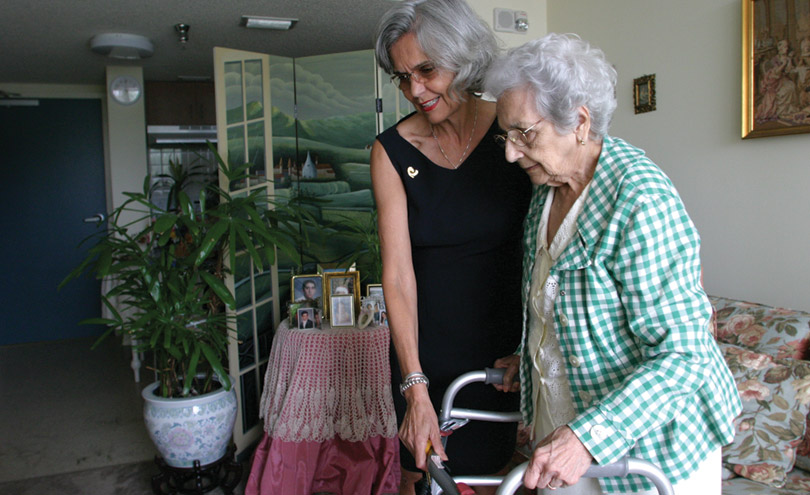
How is it funded?
Capital funding comes from a variety of sources, depending on the nature of the project. Retrofit of an existing PHA building costs US$500,000 – US$1,000,000 and is sourced from capital grants, HOME funds, federal conversion grants, home loans, and Federal Housing Assistance loans, tax/new market tax credits and tax free bonds. New construction costs of US$5 – US$10 million per facility are met from low income tax credits, new market tax credits, bond financing, FHA loans, home loans conversion and HOPE VI grants.
Operational funding is the same for both new and retrofit projects. These include rental subsidies from the federal government accounting for 70 per cent of the rent and meals, with residents paying the remaining 30 per cent, with state financial support if needed. Medicaid waivers (federal/state) provide US$900-US$1,800/resident/month, Aid and Attendance (veterans only) is US$1,701/month and the Diversion Programme (option to Medicaid waiver) US$2,200/resident/month. The cost of providing services to clients in a 100-bed facility is US$1,900/month. The net income remaining goes to make capital improvements and return on investments to owners. Mia’s activities are funded by contractor fees from PHAs and non-profit organisations that want to implement an affordable ALF model; all profits are reinvested in the organisation to help subsidise low-cost and pro bono consulting services.
Why is it innovative?
- The approach brings affordable assisted living services to public and affordable housing.
- It demonstrates the benefits of cutting Medicaid and public healthcare costs to legislators, state and federal government agencies, resulting in increased funding and policy changes.
- It uses an organisational structure in a not-for-profit activity that is based on a lean and adventurous business model.
- The project has demonstrated a proven ability to generate new revenues, new jobs and economic activity and revitalisation of neighbourhoods where it has been established.
What is the environmental impact?
In both retrofitting and new buildings Mia uses energy efficient equipment and alternative sources of energy and water supply, as well as increasing biodiversity and restoration of the planted areas. The conversion and improvement of existing buildings ensures the use of existing materials. New construction buildings are planned to include solar power, bio retention, energy star appliances, and sustainable building materials that are LEED certified.
Is it financially sustainable?
The results of the programme have shown a significant reduction of healthcare costs. The cost of provision is lower for the state funders. Mia has demonstrated that it can take public funding and serve three times as many people, and that for every resident it serves, the state Medicaid programme saves US$18,000 per year.
The current housing and financial crisis in the U.S. has worked to Mia’s benefit. Private developers and investors are now looking to the senior housing market as the only avenue to invest in, and buying distressed properties, looking for a good return with a social impact. For the past year, Mia has been working with a group of investors with a view to purchasing and managing affordable assisted living projects. In 2011 an investment fund of US$15 million was created by a group of investors to replicate this model. During the first year an average 22 per cent return on investment is achieved, in second and later years it is 26 to 30 per cent, through a combination of cost reduction, obtaining available federal and state subsidies, low turnover rates of residents, and staff and tax efficiency for public housing. Mia has generated over US$35 million in capital and operating funding for its clients nationwide, including large public housing authorities such as Atlanta Housing and Miami Dade Housing Authorities.
Concerns for the continuing Medicaid funding under existing economic conditions have not been realised. It is expected that funding will continue to grow as the federal government acknowledges the cost savings of keeping older persons/disabled adults away from institutions. Health care reform law will increase funding for this type of programme. Although it has been a difficult time to obtain capital to construct/retrofit buildings, it has been easier during the past six months given the financial viability of such projects.
Each facility generates at least 50 new jobs targeted to public housing residents, and there is a significant impact on family resources with this stage of older care being funded through Medicaid. Training of the work force and career opportunities have been provided for those employed in the ALFs, and the staff turnover rates are some of the lowest in the country. Employment opportunities are made available with priority given to residents of public housing and low income individuals in the local area.
What is the social impact?
High quality assisted living facilities are being provided through this approach, which were only previously affordable to those seniors with high incomes. Residents and their families are involved in the planning, design, implementation and management of all Mia projects, with a monthly meeting of residents and family members in each home to obtain feedback and input into programmes and services. Tenants’ forums provide a space where the residents’ voices can be heard.
Mia’s biennial evaluations have revealed a marked improvement in cognitive and physical well-being of the residents, helped by the provision of activities for residents such as weekly computer classes. These improvements enable residents to take a more active role in the community. Additionally, a reduction of prescription drugs, 911 calls, number of hospitalisations and emergency room admissions, use of wheelchairs and incidents of falls among residents has been recorded.
Mia’s facilities have the lowest rate of turnover of residents in all private and subsidised assisted living facilities in the United States (an average of 22 per cent versus 56 per cent). There is an open door policy for staff and participatory management is encouraged. Mia has one of the best rates for staff retention in the sector. There is a focus on approaching minority firms when searching for contractors.
Barriers
- Convincing state/federal governments to shift emphasis from institutionalisation to community care constituted a difficulty, especially overcoming the mind-set of individuals – legislators, bureaucrats, and some owners of public housing facilities. The lobbying strength of existing vested interests, for which the Mia approach is seen as a threat to their livelihood, constituted an additional difficulty.
- Start-up costs are high and must be financed by the owners of the property. It takes about six months from the time Mia starts conversion to the moment that the facility is generating an income. The start-up budget ranges from US$250,000 to US$500,000 and it is difficult to get funding to cover these costs.
- The current challenge is to improve replication of the programme and eliminate the waiting time.
Mia has worked to overcome these barriers through persistence and creativity, connecting with people and learning at every stage. The positive results of the project have helped to convince policymakers and the fact that ageing is a global issue has also helped focus attention.
Lessons Learned
- More can be learned from failures than successes, and persistence is key: all major innovations have been built on the grounds of rejection.
- It is important to see things from others’ perspectives, particularly in the case of government.
- Governments everywhere are suffering from a critical lack of confidence, are discredited and in need of new ideas and talented people who are focused on outcomes that would benefit the public interest.
- Setting realistic timeframes is essential, especially when engaging the local community.
- It is important to ensure that the process, as well as the aims/intentions, is understood by all.
Evaluation
Mia conducts annual evaluations of its work with an external agent (university), and there is constant monitoring by both HUD and the Medicaid programme. Financial systems are evaluated annually by both outside and internal auditors. The well-being of residents is measured regularly to assess whether the model is delivering improved outcomes in terms of mental and physical health.
Transfer
The project has been implemented by Mia in 21 states to date, with Wisconsin, Minnesota and the District of Columbia to be added in 2012. 2011 has seen the development of a detailed growth plan to guide Mia’s scaling up work from a small company to expand capacity and retain control of its mission, whilst undertaking larger projects and planning for capitalisation by large investment groups to create a paradigm shift in the affordable senior housing with services industry.
Through the auspices of Ashoka, Mia is working to transfer the programme to Spain, Costa Rica and Japan. Preliminary meetings have been held and further discussions are planned.

